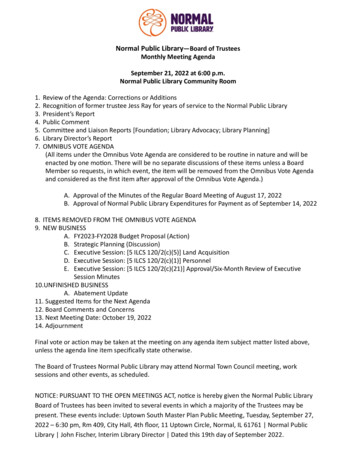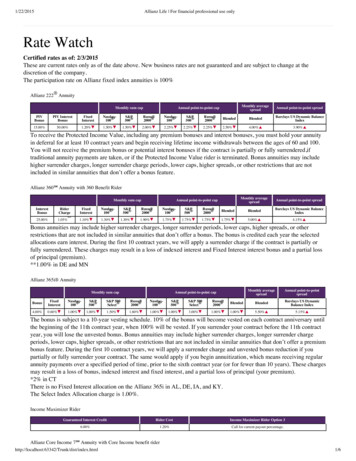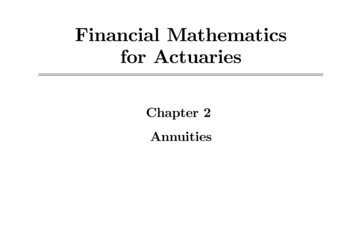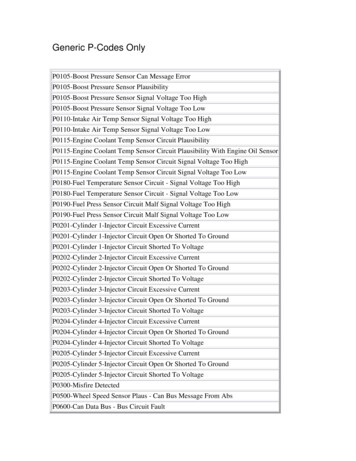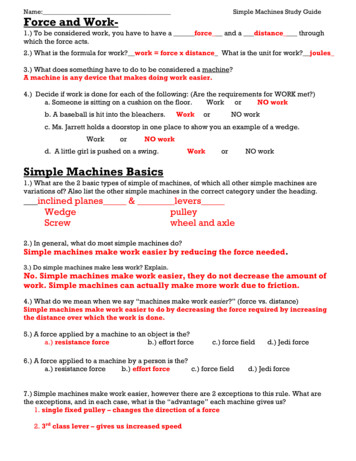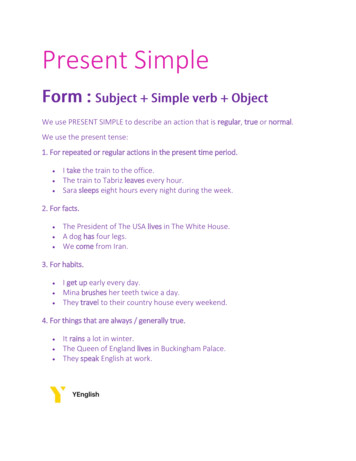
Transcription
Present SimpleWe use PRESENT SIMPLE to describe an action that is regular, true or normal.We use the present tense:1. For repeated or regular actions in the present time period. I take the train to the office.The train to Tabriz leaves every hour.Sara sleeps eight hours every night during the week.2. For facts. The President of The USA lives in The White House.A dog has four legs.We come from Iran.3. For habits. I get up early every day.Mina brushes her teeth twice a day.They travel to their country house every weekend.4. For things that are always / generally true. It rains a lot in winter.The Queen of England lives in Buckingham Palace.They speak English at work.
Verb Conjugation & SpellingDon’t forget : in the third person we add 'S' in the third person.SubjectVerbI / you / we / they speak / learnThe Rest of the sentenceEnglish at homehe / she / itspeaks / learns English at homeThe spelling for the verb in the third person differs depending on the ending ofthat verb:1. For verbs that end in -O, -CH, -SH, -SS, -X, or -Z we add -ES in the third person. go – goescatch – catcheswash – washeskiss – kissesfix – fixesbuzz – buzzes2. For verbs that end in a consonant Y, we remove the Y and add -IES. marry – marriesstudy – studiescarry – carriesworry – worriesNOTE: For verbs that end in a vowel Y, we just add -S. play – playsenjoy – enjoysNegative Sentences in the Simple Present TenseTo make a negative sentence in English we normally use Don't or Doesn't with allverbs EXCEPT To Be and Modal verbs (can, might, should etc.).
Affirmative: You speak French.Negative: You don't speak French.You will see that we add don't between the subject and the verb. Weuse Don't when the subject is I, you, we or they. Affirmative: He speaks German.Negative: He doesn't speak German.When the subject is he, she or it, we add doesn't between the subject and the verbto make a negative sentence. Notice that the letter S at the end of the verb in theaffirmative sentence (because it is in third person) disappears in the negativesentence. We will see the reason why below.Negative ContractionsDon't Do notDoesn't Does notThere is no difference in meaning though we normally use contractions in spokenEnglish.Word Order of Negative SentencesThe following is the word order to construct a basic negative sentence in English inthe Present Tense using Don't or Doesn't.Subjectdon't/doesn't Verb*I / you / we / they don'tThe Rest of the sentencehave / buycereal for breakfasteat / like etc.he / she / itdoesn't* Verb: The verb that goes here is the base form of the infinitive The infinitivewithout TO before the verb. Instead of the infinitive To have it is just the have part.Remember that the infinitive is the verb before it is conjugated (changed) and itbegins with TO. For example: to have, to eat, to go, to live, to speak etc.
Examples of Negative Sentences with Don't and Doesn't: You don't speak Arabic.Saman doesn't speak Italian.We don't have time for a rest.It doesn't move.They don't want to go to the party.She doesn't like fish.Questions in the Simple Present TenseTo make a question in English we normally use Do or Does. It has no translation inSpanish though it is essential to show we are making a question. It is normally putat the beginning of the question. Affirmative: You speak English.Question: Do you speak English?You will see that we add DO at the beginning of the affirmative sentence to make ita question. We use Do when the subject is I, you, we or they. Affirmative: He speaks French.Question: Does he speak French?When the subject is he, she or it, we add DOES at the beginning to make theaffirmative sentence a question. Notice that the letter S at the end of the verb inthe affirmative sentence (because it is in third person) disappears in the question.We will see the reason why below.Word Order of Questions with Do and DoesThe following is the word order to construct a basic question in Englishusing Do or Does.
Do/Does SubjectDoVerb*The Rest of the sentenceI / you / we / they have / needa new bike?want etc.he / she / itDoes*Verb: The verb that goes here is the base form of the infinitive The infinitivewithout TO before the verb. Instead of the infinitive To have it is just the have part.Remember that the infinitive is the verb before it is conjugated (changed) and itbegins with TO. For example: to have, to eat, to go, to live, to speak etc.Examples of Questions with Do and Does: Do you need a dictionary?Does Maryam need a dictionary?Do we have a meeting now?Does it rain a lot in winter?Do they want to go to the party?Short Answers with Do and DoesIn questions that use do/does it is possible to give short answers to directquestions as follows:Sample QuestionsShort Answer Short Answer(Affirmative) (Negative)Do you like chocolate?Yes, I do.No, I don't.Do I need a pencil?Yes, you do.No, you don't.Do you both like chocolate? Yes, we do.No, we don't.Do they like chocolate?Yes, they do.No, they don't.Does he like chocolate?Yes, he does. No, he doesn't.Does she like chocolate?Yes, she does. No, she doesn't.Does it have four wheels?Yes, it does.No, it doesn't.
Examples of Negative Sentences with Don't and Doesn't: You don't speak Arabic. Saman doesn't speak Italian. We don't have time for a rest. It doesn't move. They don't want to go to the party. She doesn't like fish. Questions in the Simple Present Tense To make a question in English we normally use Do or Does.


